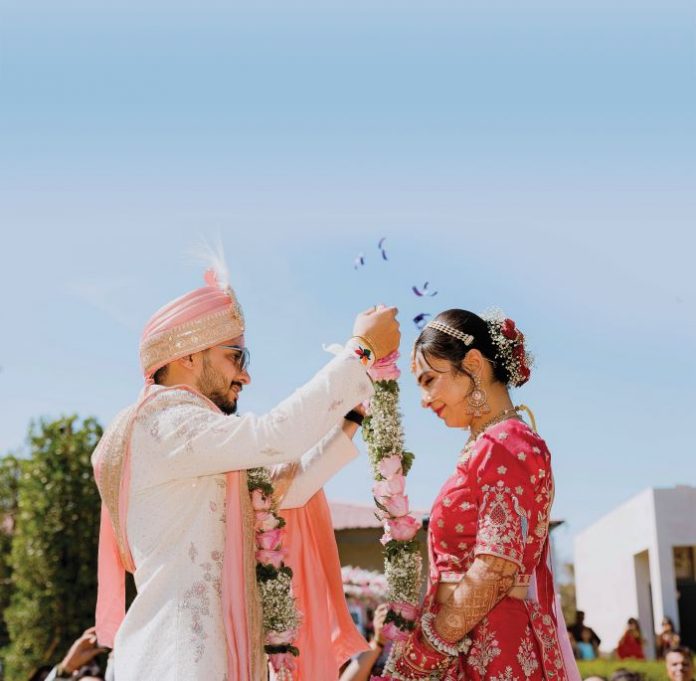‘Wed in India’ and ‘Design India’ initiatives offer the hotel sector an opportunity to customise, and elevate their wedding offerings, believes Mugdha Sinha.
By Lipla Negi
India, with its rich cultural heritage, diverse traditions, and modern facilities, has long been a sought-after destination for weddings. However, the country must expand its horizon beyond the traditional one-time tourists and focus on repeat visitors who choose India to celebrate their anniversaries and honeymoons, believed Mugdha Sinha, Director General, Ministry of Tourism.
Speaking at the 54th FHRAI Annual Convention in Goa, Sinha said, “We need to rethink our outreach strategies and create a framework to attract global clients, particularly from the Indian diaspora. The Indian wedding industry ranks second only to food and groceries, with 54 per cent of people spending an average of `10 lakhs on a wedding. Although, we have not adequately conducted outreach for weddings in the global market.”
The potential for wedding tourism in India is vast. “India’s appeal lies in its cultural antiquity, rich customs, food, and unique gifting traditions,” Sinha said. “Couples choose India because they want an authentic, culturally rich wedding experience. It is an untapped market with huge potential for growth,” she added. With the rise of the ‘Big Fat Indian Weddings,’ India is positioning itself to become a global wedding tourism hub. “Weddings are not just a big business in India; they are a part of the country’s very fabric, and the demand for destination weddings is expected to grow exponentially,” Sinha pointed out.
Eyeing emerging markets
As part of its broader tourism strategy, the Indian government is looking to attract a wider audience through its ‘Incredible India’ campaign, targeting markets with large Indian diasporas in countries such as the USA, the UK, Australia, and New Zealand. “We are not just looking at one-time visitors; we are aiming for repeat tourism,” Sinha said. “People are coming to India not just for their weddings, but also for anniversaries, honeymoons, and family celebrations, following in the footsteps of the royal couple from Bhutan, who celebrated their honeymoon in India. We already have a template for that kind of celebration,” she remarked.
Sinha added that alongside established markets, India is also targeting emerging regions such as Latin America and Africa, where community-based wedding traditions are deeply rooted. These regions, she noted, are key to expanding the appeal of Indian cities, as they resonate with the multicultural, community-oriented nature of Indian weddings.
Shedding light on the government’s future plans, she shared a key goal is to develop new wedding destinations across India, particularly in lesser-known regions, by improving tourism infrastructure and offering an array of cultural experiences. “We are focusing on destinations with proper management systems, where we can offer themed wedding experiences—making them memorable for couples,” she added. The government is working to bridge the information gap between potential wedding tourists and the businesses that cater to their needs. “We are developing our portal into a one-stop resource for wedding planners and couples, offering everything from destination details and travel diaries to booking needs,” she said.
A sustainable success
From sanskar to sustainability, she urged stakeholders to adopt planet-friendly practices for wedding events. “The big Indian wedding often leads to ecological challenges, including traffic congestion and waste management issues. By adopting sustainable practices, we can mitigate these impacts and set an example for responsible tourism,” she asserted. The Indian government is keen in making wedding tourism sustainable, to entice the new generation of wedding planners and couples. “If we can position India as a destination that is not only culturally rich but also sustainable, we can tap into these young, eco-conscious couples,” she opined.
Sinha highlighted the importance of integrating sustainable practices into the design of wedding venues. She cited the Qatar airport as an example of how design can address practical issues like crowd control and efficiency. “Let us design our wedding venues to meet the evolving needs of this business,” she advised. Emphasising on venue design, Sinha, asserted that the ‘Design in India’ initiative, recently announced by the Prime Minister, encourages hotels to collaborate with architects to design spaces that make wedding planning seamless and sustainable.
“Couples choose India because they want an authentic, culturally rich wedding experience.”
“We are developing our portal as a one-stop resource for wedding planners and couples.”
– Mugdha Sinha, Director General, Ministry of Tourism, Government of India













